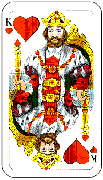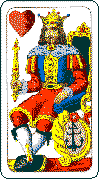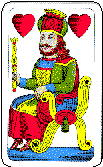Games played with German suited cards
The German suits of acorns  , leaves
, leaves  , hearts and bells were established in the early fifteenth century. There may be some very early packs that had 52 cards, but at a fairly early stage the standard German pack came to consist of 48 cards. Each suit had a king, an upper jack (Obermann) with the suit symbol at the top, a lower jack (Untermann) with the suit symbol at the bottom, a ten (sometimes shown as a banner), and further numerals from nine down to two. Presumably this full 48 card pack was used for various games, but the main one about which we have information is Karnöffel.
, hearts and bells were established in the early fifteenth century. There may be some very early packs that had 52 cards, but at a fairly early stage the standard German pack came to consist of 48 cards. Each suit had a king, an upper jack (Obermann) with the suit symbol at the top, a lower jack (Untermann) with the suit symbol at the bottom, a ten (sometimes shown as a banner), and further numerals from nine down to two. Presumably this full 48 card pack was used for various games, but the main one about which we have information is Karnöffel.
When the ace of the French and Italian packs was promoted to be the highest card in many games, the same thing happened to the two or deuce (Daus) of the German pack. Later, several games became popular in which the pack was shortened to 36, 32 or even fewer cards, by omitting what were now the lowest numerals: 3, 4, 5, sometimes 6, and so on. The deuce, now isolated as the highest card, has come to be thought of by most people as an ace, even though it has two suitmarks. In south Germany and Austria it is also often known as the sow (Sau).
German suited cards are still the primary type of cards used in many parts of central Europe. To some extent each country or region has its own variation of the pattern, with noticeably different designs. The main places where German suited cards are now used are as follows (please follow the links to the country pages for details of the games played).
- Germany
- German suited cards are in common use in the southern and eastern provinces - Bavaria, Württemberg, Saxony and Thuringia. There are several regional patterns of somewhat different appearance. In the north and west of the country, German suits have been almost entirely superseded by French suited cards.
- Austria
- German suited cards are more prevalent in the west; in the East and especially in Vienna, French suited cards are commoner. German suited cards in Austria are usually of the William Tell pattern, in which the picture cards show characters from the William Tell legend and the aces depict the four seasons of the year. These are sold as "Doppeldeutsche Karten" - "double" because like most modern cards they are double headed - the pattern is the same at each end. This is in contrast to "Einfachdeutsche Karten", in which a single pattern occupies the full length of the card. These are also (confusingly) known as the Salzburg pattern, though they are used mainly in the mountainous Western provinces of Vorarlberg and Tirol, and as Jass cards, because in Vorarlberg they are used to play Jass, though they look quite different from the cards used to play the same games in Switzerland.
- Czech Republic
- The 32 card German suited pack is in general use. There are two designs: the attractive and archaic looking single headed Bohemian pattern, which is popular in Bohemia and sold as "hrací karty jednohlavé", and the double headed "hrací karty dvouhlavé" - the William Tell pattern - which is more popular in Moravia.
- Hungary, Slovakia, Slovenia, Croatia
- In all these countries, and in Hungarian speaking regions of Romania, the 32 card William Tell pack is in general use. In this region they are often known as "magyar kártya" (Hungarian cards).
- Italy
- In the German speaking region of the South Tyrol, single headed German suited cards of the so-called Salzburger pattern are used.
- Poland
- In the formerly German southern province of Silesia, a 32 German suited card pack of the design formerly used in Prussia is still used for playing Skat.
|

Bavarian

William Tell

Salzburg

Bohemian
|
Note on William Tell cards
The characters depicted on the kings, overs and unders are from the 15th century legend of Wilhelm Tell, who is supposed to have led the Swiss resistance against Austrian domination. According to the legend, he was compelled to shoot an arrow through an apple placed on his son's head. Specifically, the characters are from the play about Wilhelm Tell written by Friedrich Schiller in 1804.
The playing-cards with these characters became popular around the time of the revolutions of 1848, probably because of the parallels with the uprisings against the Habsburg empire. The cards are used mainly in Austria, Hungary, Slovakia, Slovenia and Romania, but are unknown in Switzerland, even though the characters on them are Swiss.
In North America, German suited cards can be obtained from TaroBear's Lair.
COMMENTS








 , leaves
, leaves  , hearts and bells were established in the early fifteenth century. There may be some very early packs that had 52 cards, but at a fairly early stage the standard German pack came to consist of 48 cards. Each suit had a king, an upper jack (Obermann) with the suit symbol at the top, a lower jack (Untermann) with the suit symbol at the bottom, a ten (sometimes shown as a banner), and further numerals from nine down to two. Presumably this full 48 card pack was used for various games, but the main one about which we have information is
, hearts and bells were established in the early fifteenth century. There may be some very early packs that had 52 cards, but at a fairly early stage the standard German pack came to consist of 48 cards. Each suit had a king, an upper jack (Obermann) with the suit symbol at the top, a lower jack (Untermann) with the suit symbol at the bottom, a ten (sometimes shown as a banner), and further numerals from nine down to two. Presumably this full 48 card pack was used for various games, but the main one about which we have information is 


